Chapter 7: Women in Power and Decisionmaking
Chapter Summary
- Overview
- Profile: Michelle Bachelet
- Project: Council of Women World Leaders
- Questions
- Additional Resources
This chapter discusses the lack of women’s participation in high level legislative in executive decision making bodies and reviews current top-down initiatives to address gender gaps in the political and policy arenas. While the United Nations in 1990 called for women to hold 30 percent of parliamentary seats, only 26 out of 189 countries reached this mark by 2010. Furthermore, democracy on its own does not promote women’s participation; two of the world’s oldest democracies, the United States and France, have lower-than-average female representation in executive bodies. Affirmative action programs such as gender quotas and women-specific training programs are necessary to open up opportunities for women to engage in politics.
The chapter brings in examples of state-led progress in gender inclusion. Michelle Bachelet became the first democratically elected president of Chile and was appointed as the first head of UN Women in 2010 by Ban Ki-Moon. The Council of Women leaders was formed by Madeline Albright, first U.S. Female Secretary of State, and fosters dialogue among female democratically elected officials globally. The council also administers a fellowship program for mentoring emerging leaders in the fields of Gender and Public Policy, Environmental Policy, and Public Health.
Key Terms
- Angela Merkel
- Ban Ki-moon
- Council of Women World Leaders
- Ellen Johnson
- Inter-American Defense College
- International Parliamentary Union
- Kim Campbell
- Madeline Albright
- Madeline K. Albright Women’s Voices at the Aspin Institute Series
- Michelle Bachelet
- Ministerial Initiative on the Environment
- National Academy for Strategic and Policy Studies (Chile)
- Socialist Youth Movement (Chile)
- UN Women
- Women in National Parliaments
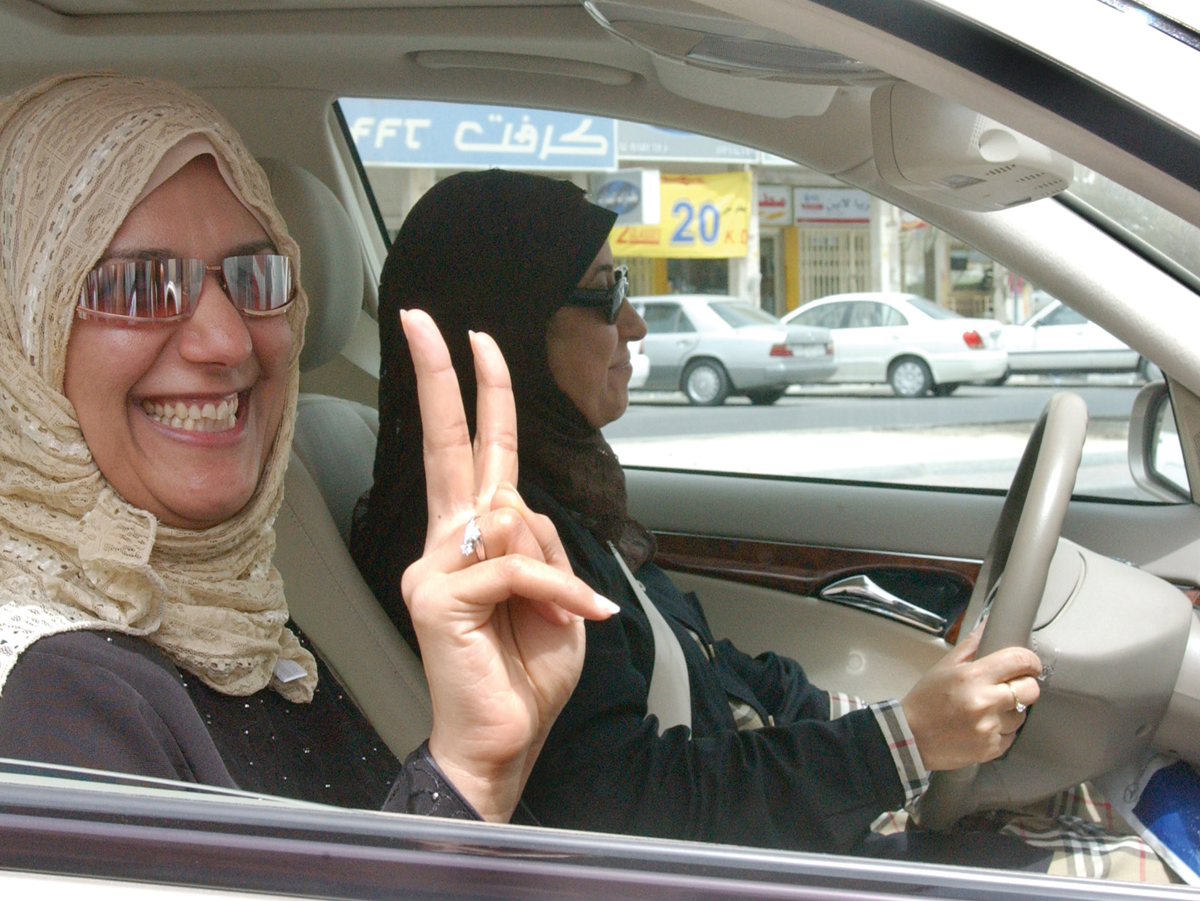
Overview
By Lori S. Ashford
Around the world, women’s lack of representation in government, especially in high-level executive and legislative bodies, limits their influence over governance and public policies. Arguably, women’s participation in decisionmaking is essential for ensuring their equality and rights. Where women have participated actively in public policy, they have been able to raise the visibility of women’s issues and work toward ending gender discrimination. But women have made slow progress in the political arena, even while making impressive gains in other areas such as education, employment and health.
Women’s Political Participation: Facts and Figures
Women’s representation in legislative bodies has increased in most parts of the world, but it is still at a low level. In 1990, the United Nations called for women to hold a “critical mass” of 30 percent of parliamentary seats — a level believed to be sufficient to bring about change in national politics. Twenty years later, only 26 countries out of 186 reached or exceeded the 30 percent mark of women’s representation in the single or lower house of parliament, according to the International Parliamentary Union. In the United States, women held 16.8 percent of seats in the House of Representatives in 2010, slightly lower than the world average of 19 percent of lawmakers in the lower houses worldwide. (Women in National Parliaments: http://www.ipu.org/wmn-e/world.htm)
These global figures conceal large regional disparities: Women make up 42 percent of parliament in Scandinavian nations but just 12 percent of Arab assemblies. A few African countries top the list: In Rwanda and South Africa, women hold 56 percent and 45 percent of seats, respectively. In Sweden, women occupy 45 percent of parliamentary seats.
Progress in women’s representation in the executive branches of government is even slower. In 2010, just 11 of 192 heads of government were women. Globally, women hold only 16 percent of ministerial posts. Finland stands out in this category, with 63 percent of Cabinet-level posts held by women.
Why Women Lack Political Power
The low proportion of women in political decisionmaking positions reflects men’s historical advantages in electoral systems and long-standing inequalities between men and women in society. At home, school, the workplace and elsewhere, girls and women typically have fewer opportunities than their male counterparts to acquire policy and leadership skills. The political arena may be least amenable to increased diversity and gender equality because it is often informal and subject to the rules of the “old-boy network.”
Democracy on its own does not create a path for women to become leaders. In fact, two of the oldest democracies, the United States and France, have low percentages of women in elected office. In most societies, women have limited access to the conventional avenues of power such as political parties, business organizations and labor unions. Lacking connections and clout, they find it harder to raise money for political campaigns. Thus, women often enter public life through alternative routes such as charities and women’s organizations.
Overcoming the Odds
Many of the political inroads women have made are due to gender quotas designed to seat more women in legislative bodies, from national parliaments to local village councils. About 50 countries have established such quotas — the Nordic countries were the earliest to put these in place — and 30 to 40 more have voluntary quotas, according to the International Parliamentary Union. In addition to quotas, women need to be trained to run for and hold office. Recruitment systems for legislative and executive positions must be more transparent.
Rwanda and South Africa saw historic jumps in the proportion of women in parliament after their national constitutions were rewritten with quotas in place for women’s representation. In other countries, such as Kyrgyzstan in 2007, 30-percent quotas have been adopted as part of election reform. In Kuwait in 2005, the all-male parliament granted women full political rights — a small but significant step in the Arab world. Many other countries have reserved seats for women on local village councils and governing bodies. In India in recent years, some states have increased the quota for women in these bodies from 30 percent to 50 percent.
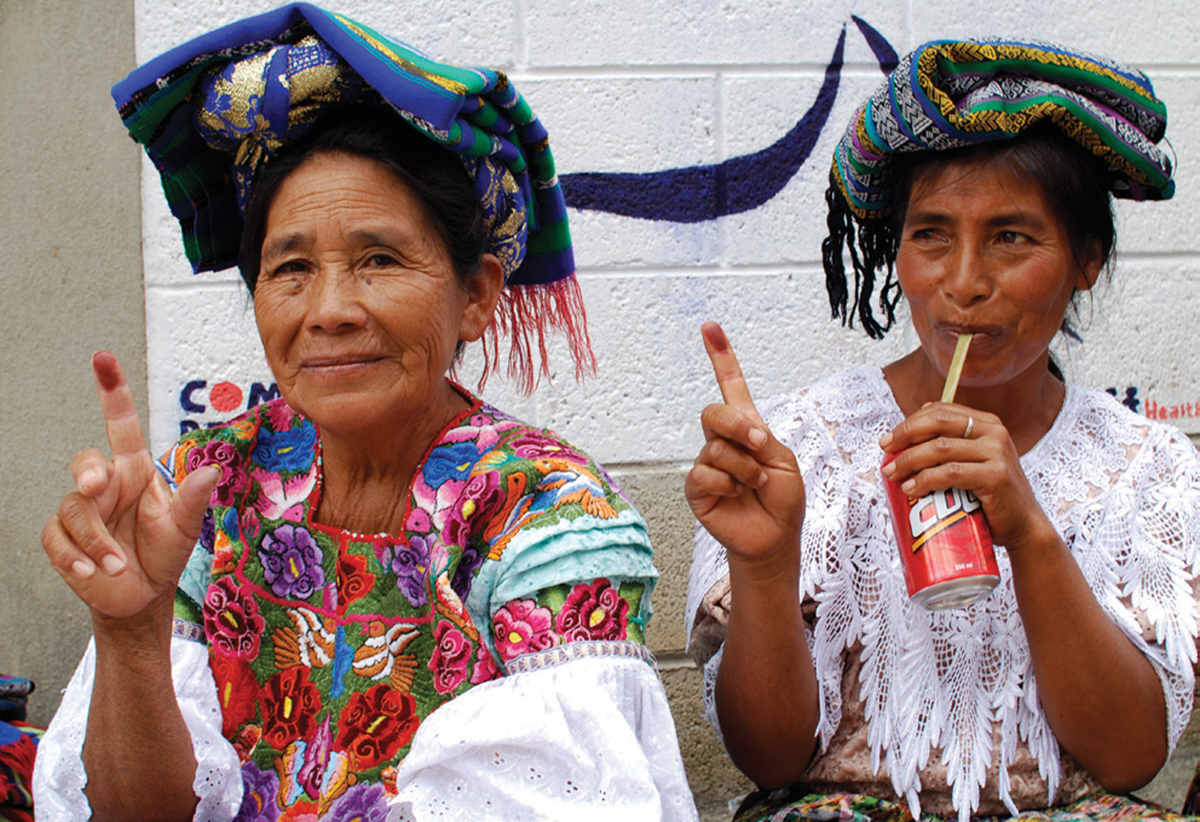
The Power of Measurement
Monitoring women’s participation in political life is critical even if the metrics used are imperfect. Women’s share of seats in national parliaments is a reliable measure because these bodies are relatively stable over time and the headcount is easily compared among countries. Granted, the percentage of seats or offices held by women reveals nothing about how fully they participate or how much power they wield. Nevertheless, establishing benchmarks for women’s progress draws attention to the issue and to ensuring that affirmative action is working. These measures wouldn’t be necessary if there was gender equality, but until that is achieved and quotas are no longer necessary, women must continue to participate actively and fight for their share of representation.
Lori S. Ashford, a freelance consultant, has written about global population, health and women’s issues for 20 years. Formerly with the Population Reference Bureau, she authored the widely disseminated Women of Our World data sheets and the Population Bulletin “New Population Policies: Advancing Women’s Health and Rights,” among other publications.
PROFILE: Michelle Bachelet – Physician, Military Strategist, Head of State
By Karen Calabria
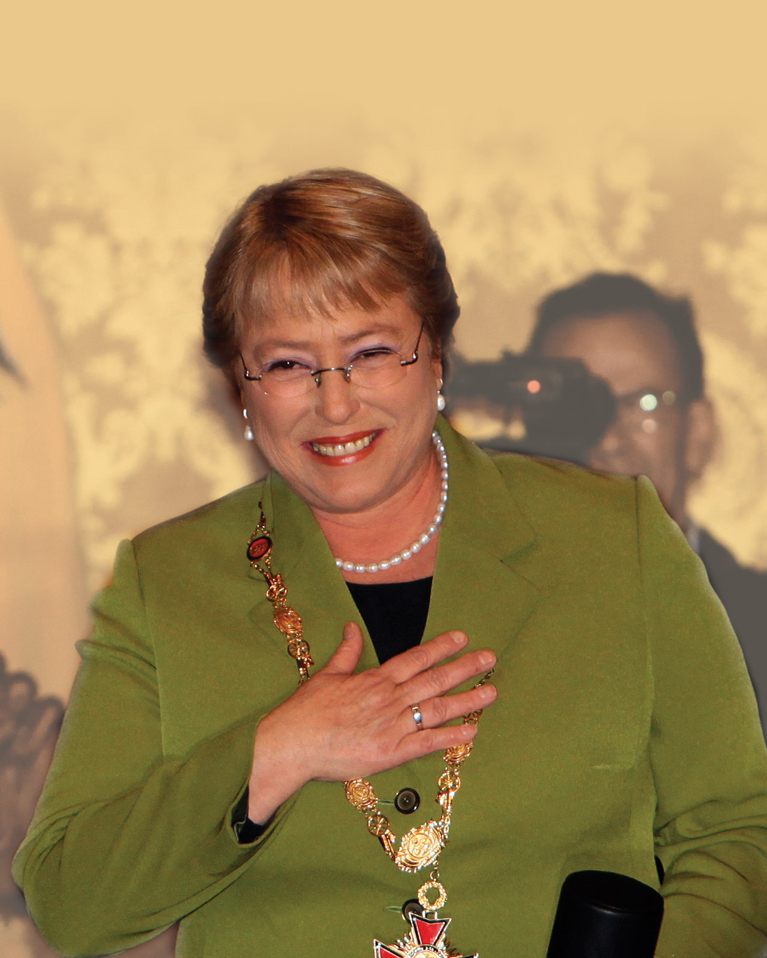
Self-professed agnostic. Divorced mother of three. Amateur folksinger. That’s hardly a recipe for political success in a country as devoutly religious and socially conservative as Chile.
But the South American nation’s first democratically elected female president, Dr. Michelle Bachelet, has never shied away from contradictions. If anything, she has created her legacy from them.
“We’ve opened the windows and doors to let ordinary people in, to encourage them to participate,” Bachelet told The New York Times, reflecting on the fractured aspects of her past that coalesced to win her the Chilean presidency.
She’s a political prisoner turned public servant who, as a government minister and Chile’s president, worked to establish a stable democracy during the transition from the brutal military dictatorship of General Augusto Pinochet.
She’s a physician — an epidemiologist and pediatrician — with a facility for healing equal to, if not surpassed by, her adeptness as a military strategist. She studied military strategy at the National Academy for Strategic and Policy Studies in Chile and at the Inter-American Defense College in Washington. In her first attempt to gain the highest political office, she emerged from the race as president, the first woman elected president of Chile.
And, at just 59 years of age, Bachelet is nowhere near finished. Recently appointed as the first head of the new United Nations agency U.N. Women, she continues to build her legacy — this time as one of the world’s most prominent activists for gender equality.
“In my family, I learned that all people should be equal in opportunities, and that justice was essential, dignity was essential. So it is in my DNA to believe in peoples’ rights and to believe we are all different and that it is great because that makes this world more interesting,” she said in an interview with Barbara Crossette that appeared in The Nation.
Those ideals experienced their first — and most trying — test during the 1973 ouster of then-President Salvador Allende by military strongman Pinochet. Her father, an Air Force general with a prominent position in Allende’s government, was taken into military custody for treason. He was tortured, and subsequently died from a heart attack as a result.
Bachelet didn’t let this deter her own political participation. Instead, she stepped up her commitment as a member of the Socialist Youth Movement. But her activities were curtailed when both she and her mother were detained at torture centers by the Pinochet regime before they fled the country for Australia in 1975.
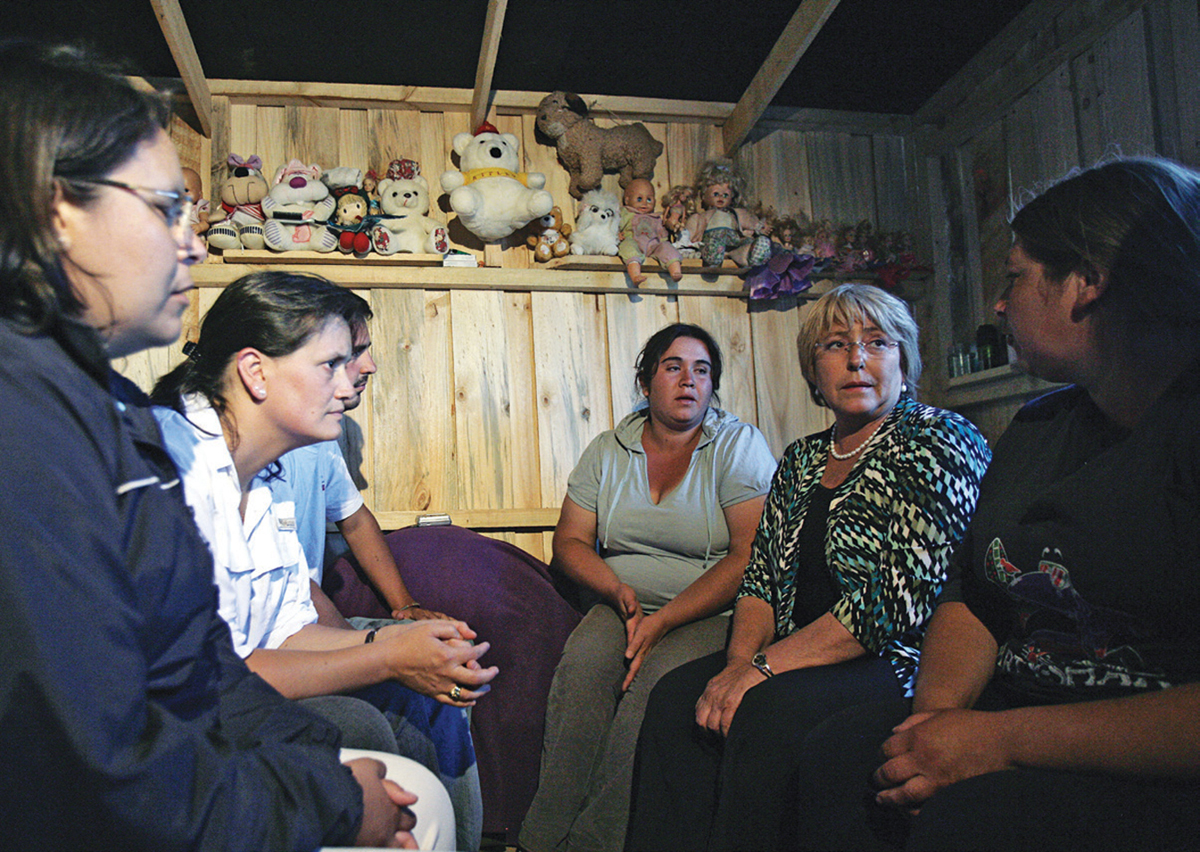
In spite of what she endured in her early years of political engagement, Bachelet made a concerted effort to address inequities in Chilean society. As minister of health, which she became in 2000, under President Ricardo Lagos, she improved access to public health care. In 2002 she was the first woman in Latin America to be appointed defense minister. During her tenure she promoted reconciliation between the military and civilian society, reforming and modernizing the Chilean military.
“Because I was a victim of hate, I’ve consecrated my life to turning hate into understanding, tolerance and, why not say it — love,” she said in her victory speech after the 2006 presidential election.
Although she began her career as a physician, quickly moving up the ladder to become health minister, she couldn’t shake the lasting influence of her father’s military background.
“I noticed that one of the barriers to full democracy was the [lack] of understanding between the military world and the civilian world. They spoke different languages. I wanted to help with that. I could be a bridge between those two worlds,” she told The Guardian of the graduate studies she undertook in military science that led to her eventual appointment as Chile’s first female defense minister in 2002.
Despite all her successes, Bachelet’s been no stranger to criticism. She’s been roundly criticized for her administration’s education policy, the failure of an ambitious public transportation plan and a series of endless labor disputes. But her approval rating is the highest of any president in Chile’s history, topping off at 84 percent when she left office in March 2010.
Yet no amount of success seems to diminish her determination to press forward with the next task. In July 2010, United Nations Secretary-General Ban Ki-moon appointed her as the first head of the organization’s newly created agency, U.N. Women.
Shortly after her appointment, U.N. Radio aired an interview in which Bachelet did not hesitate to outline some of the difficulties she faces in her new role. “In many regions of the world, women have a very difficult situation. They don’t have the same opportunities as men regarding the most essential human rights; women are discriminated [against], their rights are violated. There are still some places where women are mutilated. And so I am convinced that we need to work very hard to improve their condition, and I know it’s … very challenging work.”
And despite the legacy she’s already created for herself as one of the world’s female heads of state, Bachelet remains as committed to her vision of a better future as the youthful idealist that stood up to the same oppressive regime that had killed her father.
As she told The New York Times, “What I am mostly interested in, what I remain committed to, is less dwelling on the past than creating a better future.”
Karen Calabria is a freelance writer based in New York City.
PROJECT: Council of Women World Leaders
By Laura Liswood
At the Aspen Institute, the Council of Women World Leaders is a forum where women who serve or have served as world leaders confer to develop strategies for gender equality.
Trickle-down may be a controversial theory in any debate about the economy, but it can be a powerful approach when the goal is to promote gender equality.
That’s the high-minded end game for the Council of Women World Leaders, a top-down juggernaut of female government leaders that is using its influence to increase opportunities for women across the globe. Its mission: to mobilize the highest-level women leaders globally for collective action on issues of critical importance to women.
“Studies have shown that by the time children start school, they already have a deeply imbued sense of what it means to be male and female in their society,” says Kim Campbell, Canada’s first female prime minister, in a recent Newsweek article. “If these views support traditional gender roles, education will be hard-pressed to supplant them with something more conducive to gender equality. If we want to open up opportunities for women in public life, we have to address the landscape from which people derive their ideas of the way the world works.”
The council was conceived as one way to move that goal along. Established in 1997, it is not just another venue for high-profile officials to pose on a public stage. These aren’t the women’s networking groups of the ’80s and ’90s, but power gatherings with all the prerogatives that come with holding high office. This network of elite women aims to leverage its influence, change attitudes and eliminate hurdles to women’s progress. For example, through its Ministerial Initiative, the council provides a vehicle for a collective female voice on nettlesome global issues, shaping the agendas for multilateral policymaking gatherings to focus squarely on gender aspects.
The Ministerial Initiative on the Environment was created to address the critical need to foster sustainable development policies. The council noted in 2009 that women have primary responsibility for raising children and for securing sufficient resources for their families’ nutrition and health. So logic dictates that women’s involvement in environmental issues should increase. Given the variety of their daily interactions with the environment, women are the most keenly affected by its degradation. Yet women are severely underrepresented at decisionmaking tables on development and the environment.
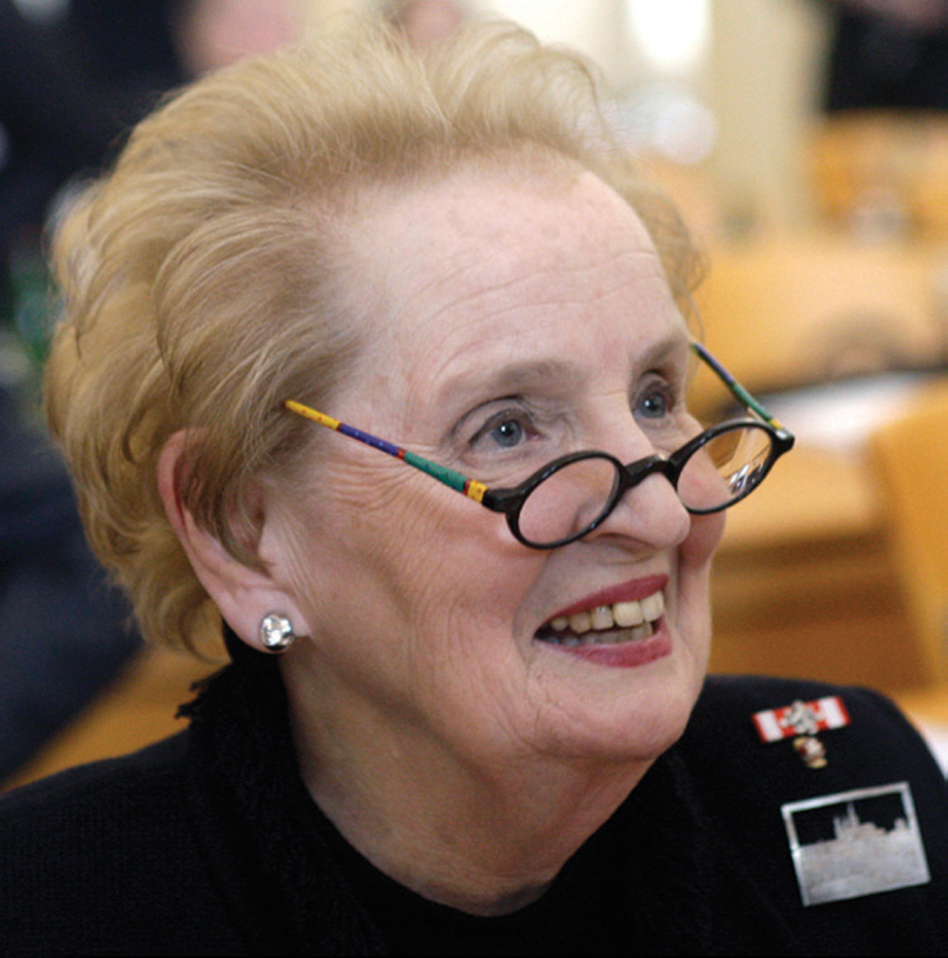
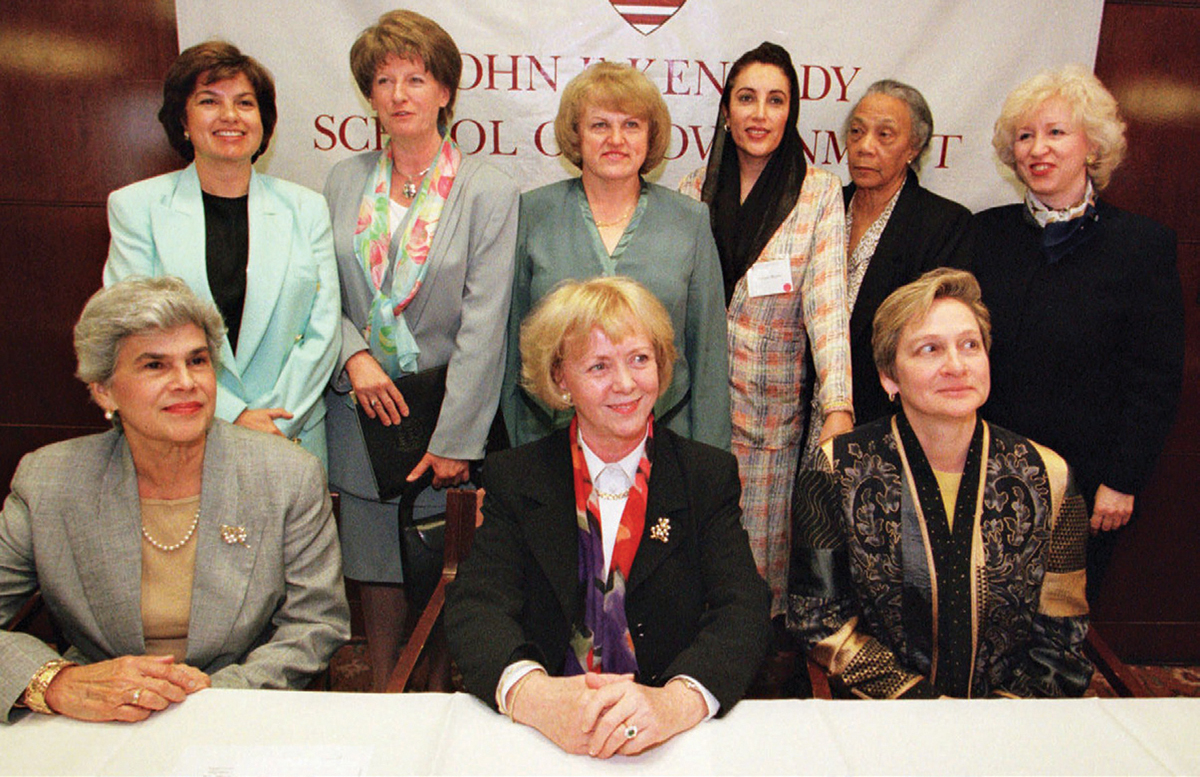
Madeleine Albright, the first female U.S. secretary of state, was founding chair of the Ministerial Initiative and an Aspen Institute trustee. To honor her contributions, a series of round-table discussions bears her name.
The council’s Madeleine K. Albright Women’s Voices at the Aspen Institute Series hosts global leaders and internationally acclaimed experts from various disciplines, who discuss and debate specific policy issues and suggest future actions for change — with emphasis on the gender dimension of the topic. Security, environmental and social matters are all seen through a gendered lens.
A winter 2010 panel, for example, featured two notable political scientists, Erika Falk of the Annenberg School of Communication and Elisabeth Gidengil of McGill University. They discussed their recent findings on female political candidates, which show it is still typically a slippery climb to the top. They found that reporters focus substantially more on men’s policy positions than on women’s, talk more about women’s physical appearance than men’s and cover the male candidates’ campaigns twice as much.
In 1996, Vigdís Finnbogadóttir, Iceland’s first democratically elected female head of state, who served from 1980 to 1996, collaborated with this author to convene women heads of government. The Council of Women World Leaders was created in 1997. Finnbogadóttir was the first chairperson. Housed at the Harvard Kennedy School of Government until 2004, the council is now a policy program of the Aspen Institute, a Washington-based international nonprofit organization that fosters enlightened leadership and open-minded dialogue.
Tarja Halonen, the president of Finland since 2000, currently serves as chair. Mary Robinson, former president of Ireland (1990-1997) and Campbell, former prime minister of Canada (1993), also have held the position. Democratically elected women presidents and prime ministers are eligible to join the 45-member council by invitation. Today it includes former President Michelle Bachelet of Chile, President Ellen Johnson Sirleaf of Liberia, Chancellor Angela Merkel of Germany and former Prime Minister Helen Clark of New Zealand, among others.
In 1998, the council expanded to include women Cabinet members. The Ministerial Initiative advances democracy, gender equality and good governance through exchanges at ministerial meetings on global issues such as health, education, environment, finance, economy and development.
The council also fosters emerging leaders through its graduate fellowship programs, which place promising graduate students in the offices of council members, international organizations and ministerial offices around the globe. Through the three branches of the program, Gender and Public Policy, Environmental Policy and Public Health Policy, fellows are provided with an opportunity to observe firsthand the ways in which leadership is manifested at the highest levels. To date, more than 160 fellows have served in 52 offices worldwide. Students from top-tier graduate schools of public health and environmental studies are placed in relevant ministries of council members and in international organizations.
The council is a unique space for dialogue on the role of women at the highest levels of decisionmaking and for the promotion of women’s issues and women in government. It offers a network of resources for high-level women leaders and facilitates a forum for a diverse group of seasoned policymakers to recommend viable solutions to inequities that afflict women today. The council’s diversity of perspective reflects the multifaceted challenges faced by women in various parts of the world.
Laura Liswood is secretary-general of the Council of Women World Leaders, which she co-founded with Vigdís Finnbogadóttir, former president of Iceland, to provide a global network for such women to share their unique experiences and learn from each other in a cooperative environment. She is a senior adviser for the global investment bank Goldman Sachs.
Multiple Choice Questions
- According to the chapter, in which sector have women made the least progress toward gender equality?
- Education
- Employment
- Health
- Politics
- None of the above
- In 2010, what proportion of UN member states had increased their share of women representatives in parliament?
- 26 out of 186
- 50 out of 186
- 70 out of 186
- 20 out of 186
- None of the above
- In 2010, what proportion of heads of government were women?
- 20 out of 192
- 15 out of 192
- 13 out of 192
- 11 out of 192
- None of the above
- Countries in which region were the earliest to issue gender quotas for national parliaments and local councils?
- North America
- Nordic countries
- Latin America
- Central Europe
- The United States and France both have low percentages of women in elected office, demonstrating that…
- Democracy on its own will not create opportunities for women to become leaders
- Republics are less effective at promoting gender equality than constitutional monarchies
- Commonwealth countries have higher levels of women in elected positions
- All of the above
- None of the above
- The “old-boys network” creates barriers to women entering politics through most formal political organizations EXCEPT…
- Political parties
- Labour unions
- Business organizations
- Charities
- None of the above
- Which of the below describes a trickle-down approach to promoting gender equality?
- Mobilizing high-level women leaders to act on issues of importance to women
- Recruiting men for roles in sectors that are feminized
- Labour unions working to organize low-wage women workers
- Increasing the social value of household and domestic labour
- Which sub-Saharan African countries saw historic jumps in the proportion of women elected representatives?
- Ethiopia and South Africa
- Ethiopia and Rwanda
- Rwanda and South Africa
- Namibia and Zambia
- None of the above
- Immediately after the 1973 Chilean coup, in which Pinochet assumed power, Michelle Bachelet became a member of which organization?
- World Federation of Democratic Youth
- Socialist Youth Movement
- Communist Youth of Chile
- Socialist Party of Chile
- None of the above
- Which is a limitation of measuring women’s participation in politics?
- The percentage of seats held do not reveal details about positions of power or levels of participation
- Affirmative action may harm efficiency
- Quotas can lead to animosity among colleagues
- Affirmative action programs give women and other minorities unfair advantages
- None of the above
- The first female U.S. secretary of state was…
- Ellen Johnson Sirleaf
- Madeleine Albright
- Kim Campbell
- Helen Clark
- Political scientists Erika Falk and Elisabeth Gidengil wrote on what findings about women politicians in the media?
- The media pays more attention to women’s personality traits
- The media focuses on men’s policy positions and women’s physical appearances
- The media covers men’s campaigns twice as much as women’s campaigns
- All of the above
- None of the above
- The International Council of Women Leaders…
- Uses its influence to increase opportunities for women across the globe
- Fosters enlightened leadership and open-minded dialogue
- Administers a graduate fellowship program for emerging leaders in the public policy field
- Includes democratically elected women by invitation
- All of the above
Answers
- The correct answer is politics (answer D). The text states that women have made gains in education (answer A), employment (answer B), and health (answer C), but have yet to make the same progress in the political arena.
- The correct answer is 26 out of 186 (answer A).
- The correct answer is 11 out of 192 (answer D).
- The correct answer is the Nordic countries (answer B).
- The correct answer is A. Despite the fact that the U.S. and France are two of the world’s oldest democracies, they don’t display higher gender equality in politics. There is also no evidence of causation in the relationship between a country’s republic or commonwealth status and its gender equality (answers B and C).
- The correct answer is charities (answer D). Political parties (answer A), labour unions (answer B), and business organizations (answer C), are described as subject to the “old-boys network” of formal organizations, and can be difficult for women to gain access.
- Mobilizing high-level women leaders to act on issues of importance to women (answer A) is correct.
- The correct answer is Rwanda and South Africa (answer C).
- The correct answer is the Socialist Youth Movement (answer B). The World Federation of Democratic Youth (answer A) is incorrect. Michelle Bachelet’s current affiliation is with the Socialist Party of Chile (answer D). The Communist Youth of Chile is another prominent youth movement (answer C), though Michelle Bachelet was not a member.
- The correct answer is that the percentage of seats held by women do not reveal their position of power or their levels of participation (answer A). Consensus in political science is that affirmative action programs and quotas do not harm efficiency (answer B), lead to animosity among colleagues (answer C), or give women and other minorities unfair advantages (answer D). These measures are necessary because gender equality has yet to be achieved.
- The correct answer is Madeleine Albright (answer B). Ellen Johnson Sirleaf was the president of Liberia and Africa’s first female head of state(answer A), Kim Campbell was Canada’s first female prime minister (answer C), and Helen Clark is the former prime minister of New Zealand (answer D).
- The correct answer is D (all of the above). All of the answers were part of Falk and Gidengil’s findings on women politician’s media representations.
- The correct answer is all of the above (answer E). Each of the options are important aspects of the International Council of Women Leaders.
Discussion Questions
- In what ways would a liberal democracy be more conducive to increasing gender equality among elective representatives? How can democracy pose barriers to gender equality?
- Select a national or international context and do external research to discover what programs or systems exist to increase women’s representation in government or the private sector in that context. Are they effective? Are there any challenges?
- Is adding women to existing policies and programs all that is necessary to create gender equality?
- What are the benefits and limits of gender-equality efforts focusing on women who are in leadership roles?
- What are some myths that prevent women from accessing leadership roles? How can they be addressed?
Essay Questions
- The chapter mentions that ‘trickle-down feminism’ is a controversial topic. Using the resources provided, summarize the debate surrounding trickle-down feminism and consider alternative approaches.
- Is it a commonly accepted idea that women have different leadership styles than men? Research on your own to make a case for whether these different styles result from biological differences or socialization through gender-specific experiences, and offer concrete examples.
- Do the problems associated with a lack of women in leadership reside more with the inadequate number of women in leadership or the fundamental structure of organizations?
Additional Resources
ABC News. “Gillard Labels Abbot a Misogynist.” (2012).
Gillard speaks to the challenges facing women in politics in Australia and exposes misogyny among colleagues.
https://www.youtube.com/watch?v=ihd7ofrwQX0
Albright, M. TED-Ed. “On Being a Woman and a Diplomat – Madeleine Albright.” (2013).
TED Talk by Madeline Albright, the first female U.S. Secretary of State on her experiences in the diplomatic world through a gender lens.
https://www.youtube.com/watch?v=7wzceILi774
Al Maaitah, R. Oweis, A. Olimat, H. Altarawneh, I. & Al Maaitah, H. “Barriers Hindering Jordanian Women’s Advancement to Higher Political and Leadership Positions.” Journal of International Women’s Studies 13(5), 101 – 122.
Draws from a cross sectional survey of 500 Jordanian women to identify obstacles to advancement and discrimination within institutions among a variety of sectors.
http://vc.bridgew.edu/jiws/vol13/iss5/10/
Amin, M. & Islam, A. “Women Managers and the Gender-Based Gap in Access to Education: Evidence from Firm-Level Data in Developing Countries.” World Bank. (2015).
Firm-level study finding that countries with a higher proportion of female managers have higher female enrollment rates in primary, secondary, and post-secondary education.
O’Neil, D. & Hopkins, M. “The Impact of Gendered Organizational Systems on Women’s Career Advancement.” Frontiers in Psychology, 1 – 4: (2015).
Pays attention to systemic gendered norms and structures that impact women in workplaces.
https://doi.org/10.3389/fpsyg.2015.00905
Ditchburn, J. “’Because it’s 2015: Trudeau Forms Canada’s First Gender Balanced Cabinet.” CBC News. (2015).
Commentary on Canadian Prime Minister Justin Trudeau’s decision to form Canada’s first gender-balanced cabinet.
http://www.cbc.ca/news/politics/canada-trudeau-liberal-government-cabinet-1.3304590
Farnsworth, N. “Gender Responsive Budgeting.” TEDxPristinaWomen. (2015).
Explains the meaning, procedures and impacts of gender-responsive budgeting.
https://www.youtube.com/watch?v=mA8L2oqDbHs
Jaffe, S. “Trickle-Down Feminism.” Dissent. (2013).
Discusses the dangers of focusing exclusively on women in high-level leadership positions, remembering that women are also overrepresented in minimum wage and informal sectors.
https://www.dissentmagazine.org/article/trickle-down-feminism
Saadin, I. Ramli, K. Johari, H. & Harin, N. H. “Women and Barriers for Upward Career Advancement – A Survey at Perak State Secretariat, Ipoh, Perak.” Procedia Economics and Finance 35, 574 – 581: (2016).
Examines the relationship between work-life balance and gender stereotypes of women in the public sector.
Westervelt, W. “Having It All Actually Kinda Sucks for Women.” Everyday Feminism. (2016).
Analyzes the domestic and care burdens that have persisted even though women have moved into the formal and paid sector.
http://everydayfeminism.com/2016/07/having-it-all-kinda-sucks/
The World’s Women 2015. “Power and Decision-Making.” (2015).
Annually updated data and analysis on women in leadership, within the public sector, private sector, and media.

